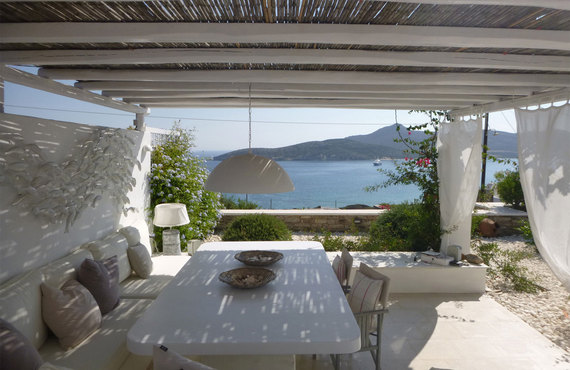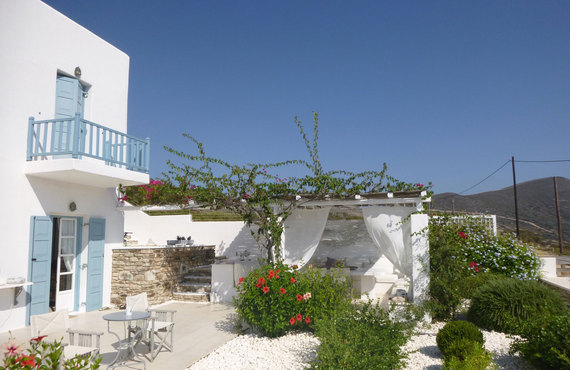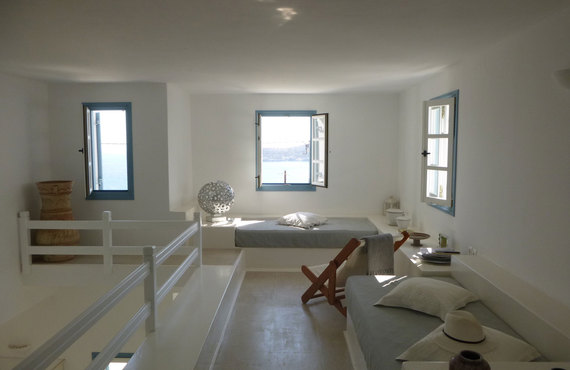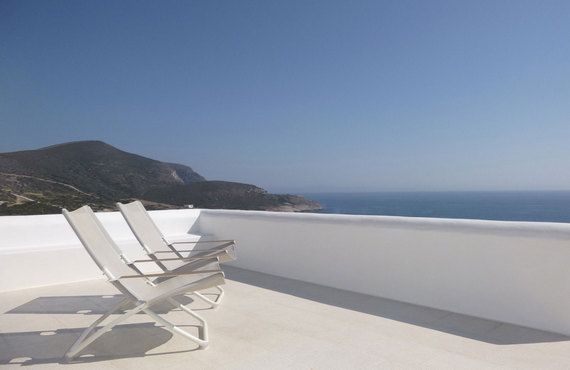
Image courtesy ds-tma
The Cycladic islands are the reason why most people's first reaction to the statement, "I'm going to Greece," is, "Take me with you!"
Can they be blamed?
After all, this is the tranquil destination of myth and legend that's resided in the minds of wander-lusting daydreamers and true-life travelers alike for the past few centuries. And for good reason...
Can anything be more idyllic?
Picture it: pristine, whitewashed buildings, sundrenched beaches and spectacularly deep blue, clear-as-crystal waters. Not even the international news media's focus and seemingly great delight these past few years on the negative plagues of the country (i.e. subversively unbuttoned, rumple-clothed politicians and rightfully disgruntled, demonstrating citizens) have managed to dampen most people's love affair with this small island group in the Aegean archipelago.

Image courtesy ds-tma
However, I was surprised to find out (as indeed, you might be too) that the serene blue of the sea offset by the white of the buildings wasn't always the norm. At least, the blue sea was but, in fact, the whitewashed allure of the sparse buildings wasn't the result of a romantic inclination.
Architect, Dimitris Sakellariou, who specializes in building sustainable, high quality, holiday housing, told me that, "The world renowned 'typical' white Cycladic home isn't historically accurate. It's actually the result of a 1938 decree which enforced the use of lime to whitewash all buildings in the Cyclades for health reasons. Later on, in 1955, Queen Frederica chose that the photo of one such whitewashed home with blue painted window panes to be used in Greece's then tourism campaign." Needless to say, it was a successful campaign and for all intents and purposes, the whitewashing has now become synonymous with our recognition of the Cyclades. In fact, it's become the perfect "wrapping" for the sparse, unadorned and unencumbered local architecture.
The thing is that Cycladic architecture is without "frills and ruffles" because it doesn't need any. Its innate qualities and building materials are of such a caliber that there's no need to "decorate" them to offer improvement. Just like in fashion, the simplest items are usually the most appreciated and coveted; just look at the Hermes Birkin handbag. The craftsmanship and quality of its construction speaks for itself; same in Cycladic architecture. (If you know me then you won't find it strange that I'm comparing a building to a handbag -- great design is great design no matter its form or function). After all, that's what true luxury is about. When one doesn't have to convince anybody else.

Image courtesy ds-tma
"The Cycladic style is the result of a response processes in the housing needs of the inhabitants of the Cyclades through the centuries," Dimitris says. "The form of the houses has been dictated by the climatic conditions (the hot sun, high winds, and sometimes overabundance of light led to the use of small window openings), the availability and format of materials used (i.e. the length of available timber for construction) as well as the need to protect inhabitants against any aspiring conquerors (hence, the more traditional stone facing that helped the buildings blend into the environment)."
It's no wonder that in 1939, Le Corbusier, the Swiss-French architect and urban planner, stated that, "Whatever architecture had to say it said it here," and that an architect has to have studied the architecture of Mykonos (possibly the most well renowned Cycladic island) before they have the right to call themselves an architect.
But Cycladic design is more than just a style of architecture. It's a style of life. Seamless, easy, stress-free, devoid of clutter (in any sense or meaning of the word) and simple, stripped down to its essence. That's what draws people the world over to it. People yearn for that lifestyle and for the integrity that Cycladic architecture represents. "The Cycladic house doesn't consist of just the walls that define it," Dimitri agrees, "It goes beyond the walls to the homes' exterior living spaces and encompasses the groups of friends and family that gather together under the shade of the pergola, with the sea beside them and the scent of ripe figs and grapes in the air around them."

Image courtesy ds-tma
Moreover, not only is it "sustainable" towards the environment but it's been so before sustainability became a "thing" in people's consciousness, back when it was simply the logical choice; when people still inherently respected the environment because they knew that their lives depended on it. Back then, sustainability wasn't in order to make a statement but, rather, to make a life. "Cycladic architecture is eminently sustainable, since it takes into account the three pillars of sustainability; namely society, the environment and the local economy," Dimitris says, sighting as an example the integral importance the cistern plays in the function of a Cycladic house for it collects water, a precious commodity during the torrid, dry summer months. "Also, the knowledge of the local craftsmen, who use local materials and build in such a manner that doesn't negate the qualities of the environment and landscape."
So, yes. There's a reason that when one mentions "Greece" to anybody outside the country, the image that springs to their minds is that of a sundrenched, whitewashed stone building hugging the side of an arid hillside, high above an intensely blue sea and they are filled with the sudden desire to somehow transport themselves into that picture. We intrinsically yearn for the Cyclades perfect, authentic simplicity. It's calm. It's reliability. In all the madness of what is deemed "important" and "noteworthy" in this crazy modern world of ours it offers a respite. It encourages us to just... be.